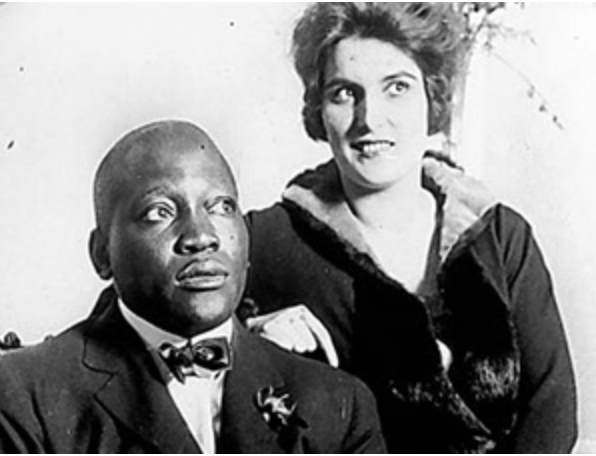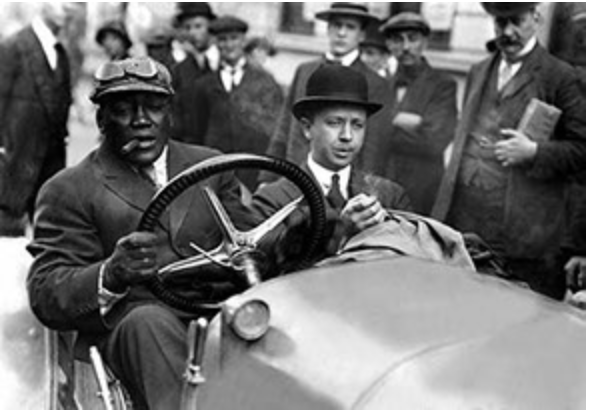BOOK REVIEWS
Jack Johnson with one of his wives
Jack Johnson behind the steering wheel
Unforgivable Blackness: The Rise and Fall of Jack Johnson
Geoffrey C. Ward
Sunday Times
5 February 2006
When Jack Johnson beat Jim Jeffries in 1910 and was officially given the title of world heavyweight champion, the first black man to achieve this title, he became “the most eminent black man in the world” and both a target and an excuse for the vengeful desires of the world’s affronted white population. “No event since emancipation forty-five years earlier seemed to mean so much to Negro America as Johnson’s victory,” says Geoffrey C. Ward in this spirited biography. “And no event yielded such widespread racial violence until the assassination of Dr. Martin Luther King, Jr., fifty-eight years later.”
An attention-getter since childhood, Johnson was an extraordinarily self-possessed individual. He started out as a dockside fighter, then graduated to taking part in battles royal, which consisted of a dozen or so black men, gloved and blindfolded, flailing at each other until the last man was left standing, all for the amusement of white swells.
Boxing matches between black and white fighters were known as speckled or piebald bouts, and Johnson was described as Abyssinian, Ethiopian, dark meat, his remarks invariably reported in Uncle Remus dialect. “Texan watermelon pickaninny makes dents,” was one early headline. Another world heavyweight champion, John L. Sullivan, had refused to fight black challengers, echoing the sentiments of newspaper editor Charles Dana who regarded the emergence of such challengers as “a black rise against white supremacy”.
As a fighter, Johnson was said to have a perfect stance and an uncanny ability to dodge punches. “A man who can move like you,” said one veteran fighter, “should never have to take a punch.” His confidence and wit made him adept at “mouth-fighting” (taunting his opponent) or talking back to his opponent’s trainers or the boxing reporters at ringside, maintaining an ironic commentary on a match.
Johnson was undoubtedly a showman, a teller of tall tales about his exploits, and a flashy dresser with a penchant for diamond jewellery, fast cars, and bohemian women, especially those who worked in “sporting houses” (or brothels). Later, fast automobiles were the prime object of his conspicuous consumption. “There were fewer than half a million cars in the United States in 1909; by year’s end Jack Johnson would own five of them,” explains Ward. Needless to say, he was often caught speeding and would blithely peel a large bank note from his wad.
Johnson’s Achilles heel was white women. His second wife, Etta Duryea, was white. When she committed suicide, her mother said that although she had never been right in her mind, “her suicide came at a period, not of temporary madness, but of ultra-lucidness”. Within months Johnson married another white woman, Lucille Cameron, despite the best efforts of her mother to have him prosecuted for kidnapping. The governor of Virginia demanded his lynching; even the governor of New York declared the wedding to be “a blot on civilization”.
“I never will believe that he married his white women just to spite white people,” said a friend. “I just think he did what he wanted to because he wanted to do it.” It was this attitude that not only angered whites but alienated high-minded, accommodationist blacks, who accused him of hampering black progress by “creating unusual scenes in barrooms, cafés or on public highways”.
The US federal government finally prosecuted Johnson under the Mann Act, a law designed to stamp out a white slave trade that was largely the figment of the public’s overheated imagination. Since one could be prosecuted for transporting a woman across state lines for the purpose of debauchery, let alone prostitution, a trumped-up case was prepared involving a prostitute who happened to have been Johnson’s former companion on tour. Charges alleging that he had also committed “the crime against nature” (i.e., oral or anal sodomy) were dropped for lack of evidence. Johnson was convicted, but managed to flee to Canada and thence to Europe. He spent the next several years in exile, losing his title to a white man, Jess Willard, in Cuba in 1915. When he returned to the United States to serve his prison term, he took easily to prison life, treating the warden and guards as his equals.
His later career was a disappointment. Finding it hard to acknowledge the decline of his celebrity, he resented the model behaviour of another black champion, Joe Louis, and was in turn resented by Louis’ black fans. He died in 1946 – during his third marriage to a white woman – in a car crash.
This is not primarily a sporting biography – indeed, it has more to say about race than boxing. In a narrative with plenty of thrills and spills, Geoffrey C. Ward has done full justice to Johnson as a spellbinder and a subversive force (“profligate, arrogant, amoral, a dark menace, and a danger to the natural order of things”). Equally, he has trawled through the popular press of the day and gives a compelling picture of the sheer cliff of prejudice that Johnson had to climb. It is down to Ward’s skill that even when Johnson is at his most self-destructive we continue to feel empathy for him. But the keynote is Ward’s recognition of Johnson as a wilful, dignified man of courage, who refused to conform meekly to the expectations of others.


